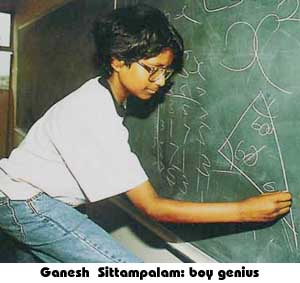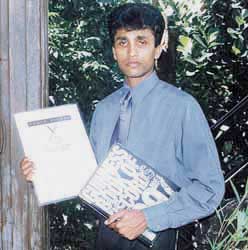



Have you heard about the world's longest loaf of bread ? Imagine this.
When unravelled this twisted loaf, baked in Acapulco,  Mexico
was longer than the Everest mountain. At a whopping 9200 meters, it stood
taller than the tallest peak. This even sounds tame when compared with
the 47 kilometre sausage and the talking bird with a vocabulary of 1728
words.
Mexico
was longer than the Everest mountain. At a whopping 9200 meters, it stood
taller than the tallest peak. This even sounds tame when compared with
the 47 kilometre sausage and the talking bird with a vocabulary of 1728
words.
These are but glimpses of the latest edition of the book that lists the world's most unusual facets- Guinness Book of 1998. Among its thousands of entries are stories of the success of the Spice Girls, Socks' the White House cat who receives 75000 letters and parcels every day, a land living fish and the most foul smelling plant.
Almost every country had found its way into the book, through chance or creation. Sri Lanka too has its place in the 1998 Book. Paradoxically Sri Lanka's fame is in its Cricketing heroes and the number of suicides and snakebite deaths that occur in one year.
The good news first. Although our World Champion team of cricketers have smashed many a record in one day and test cricket, only two entries have managed to get into this edition of the book. Both are individual achievements. Sanath Jayasuriya for the highest number of sixes in a one day match and Hashan Tillekeratne for the highest number of catches in a match. Sanath's record of 11 sixes is shared with Shahid Afridi of Pakistan and Hashan's record of seven catches is shared with two others, Greg Chappell and Yajurvindra Singh. He equalled the others' records both set in the 1970s while playing a test against New Zealand in 1992.
On the darker side, Sri Lanka's suicide deaths for the year 1991 are
included as a record high in the entire world. 47 deaths  were
reported per 100,000 of the population. No other details are given in the
book. In comparison the lowest suicide rate is reported from Jordan. A
stunning difference of 0.04 per 100,000. We as a country also hold the
Guinness record for the highest number of snake bite deaths. For a country
as small as ours, the number of fatalities due to snake bites by the Common
Krait, the Cobra and Russell's Viper amounts to around 800 per every year.
The book also carries a colour picture of a snake bite victim being treated
with native anti venin, which consists of a gooey paste made from locally
sourced herbs.
were
reported per 100,000 of the population. No other details are given in the
book. In comparison the lowest suicide rate is reported from Jordan. A
stunning difference of 0.04 per 100,000. We as a country also hold the
Guinness record for the highest number of snake bite deaths. For a country
as small as ours, the number of fatalities due to snake bites by the Common
Krait, the Cobra and Russell's Viper amounts to around 800 per every year.
The book also carries a colour picture of a snake bite victim being treated
with native anti venin, which consists of a gooey paste made from locally
sourced herbs.
But the snakes listed as the world's most venomous are not found in Sri Lanka. Two species of sea snake and a small scaled land snake are the most venomous snakes found world wide.
Among the world's most dangerous killer animals is the Piranha. Giving a new twist to 'Jaws', in September 1981 more than 300 people were reportedly killed and eaten by schools of Piranhas when an overcrowded passenger boat capsized in Brazil.
Ever heard of cats with wings ? The book has a picture of a black cat found in Manchester with two wing like appendages striking out of its fluffy black coat, sometime in the 1970s. It is reportedly not the first winged cat to be found in the world either.
Even Ghosts and aliens have not been omitted from this very special book. There are pictures of an 'alleged' autopsy of the body of an alien found near a wreckage of a disk like object in New Mexico. One is also treated to pictures of Big Foot captured on camera by a rancher in the USA in 1967.
On a more serious note, British born Ganesh Sittampalam, whose parents migrated from Sri Lanka is a record holding genius who became Britain's youngest graduate this century, obtained a degree in Mathematics at the age of 13 years and 5 months. He is also the youngest to have passed the A/level examination.
Maybe if you have special talents and skills or possess some extraordinary collection, you could also enter the Guinness Book. But criteria for entering the book is strictly specified and for most categories the Guinness Book of Records has special guidelines for qualifications. Each achievement is carefully weighed before it is included in the book.
Standing on one foot for 76 hours and 40 minutes, Suresh Joachim made
a Guinness record for endurance. But although the  28
year old businessman expected his record to appear in the 1998 edition
of the book it has failed to replace the existing record held by an Indian.
28
year old businessman expected his record to appear in the 1998 edition
of the book it has failed to replace the existing record held by an Indian.
Joachim would be remembered by readers as the young man who ran continuously for 1000 hours around the Vihara MahaDevi Park last year. He has also bettered records so far held by Yiannis Kouros of Greece in long distance running. In December he hopes to travel to Toronto to better the present record for backward walking.
His plans do not stop here. Next year Joachim will try to break the record for 58 hours of continuous clapping and in the year 2000 he will attempt 217 days of non-stop ball room dancing. Who will be his partner? Well, he has someone in mind but that's still a secret.
His last attempt will be to travel around the world to 180 countries in the shortest time. All this, Joachim says, is for a cause. Money collected from record-breaking efforts will go to charity for the betterment of destitute children.
Chitral Jayatilleke recalls his best shot yet of an elusive beast of the jungle
It was May, 1993. We were on our way to Yala for the third time that year. As we reached Tissa, our customary stopover, we could see the effects of a law pressure system prevailing over the eastern coast- line and the gloomy skies hinted that the rains were not too far away. Depressed over the weather but undeterred, we arrived at Yala well before noon to be greeted by our guide Somapala who in time has become almost a certain partner in our team.
Somapala had excellent news for us. He had observed a Leopard on a particular tree in the park for two consecutive days in the early hours of the day.
Delighted with the news we drove up to the bungalow 'Old Buttuwa' which would become our home for the next three days. By the side of the Buttuwa rock in close proximity to where the ocean meets the wilderness, Old Buttuwa remained one of my favourite getaways until it was completely destroyed recently by the now famous 'group of armed men' as they are recognised by the Department of Wild Life Conservation.
Our plans for the next day were obvious - and as the first light appeared, we dashed to the location where the Leopard had been sighted in the previous days. As we approached the giant Palu tree near the Buttuwa junction observing a strict code of silence, there was nothing on the tree nor on the environs. We stayed for the next half an hour. As the light became stronger with the tourist jeeps bound to appear on the main road, we decided to drive along as we did not want to give away our secret.
The next morning we again hit the track arriving at the Buttuwa junction well before 6 a.m. Our attempt to see this master of disguise drew a blank again as the giant Palu tree stood by itself, nothing other than the morning light touching the highest branches lighting them up in the most magnificent manner.
It was the third morning. We persisted, determined to catch a glimpse of this most elusive creature. But we were again disappointed as we found nothing on our tree. By now I could almost remember every branch on this tree.
That evening along the Uraniya road we spotted two young bulls intensely engrossed in playing by the side of the Uraniya wewa. When we saw them first they were quite submerged in the water but they later came out and continued the affectionate playing until it was time for us to drive back to the bungalow.
Later back in the bungalow, I climbed the Buttuwa rock with my friend Thusith and Somapala and sat by the kema (small rock pool) as we discussed what our chances might be the next day, as we were due to get back to Colombo the following day. Sitting there in the most tranquil environment with the forest spreading as long as the eye could see, I remembered every line of a phrase of John Still's Jungle Tide. It goes "Sitting at night by a water hole in fascinating enough to gild its morality, to listen to the sounds of a kingdom wherein human beings have no place except as intruders."
It was our last morning. Well, before dawn we were all in the vehicle carefully approaching our tree as we knew that Leopards are less tolerant to any human presence than most animals. It was 6.15 a.m. Forty meters from the tree, Somapala with his head outside said - 'Sir, he's there'. There he was indeed, in all his feline splendour on a mode of surveillance of his territory at day break.
As Thusith was driving and the tree was on the side of the driver, I had to place my tripod on the driver's seat almost sitting on the hand brakes of the vehicle as I focused on this lethal beauty. With the shutter speed at one thirtieth of a second with a full open aperture through a 300 mm lens, I felt as if I could almost touch him. Though for a moment I stopped thinking and my reflexes took over, I had switched off the motor drive to avoid making any noise and as I took four frames, this king of the trees stood up almost as if it was well aware of our presence, gently climbed down and disappeared into the thicket leaving us leaping in joy. We knew we had made a classic sighting and if the pictures were successful, it might be the ultimate reward the jungle might offer one.
Later in Colombo as we developed the film I realised how lucky I had been and how much we all owed Somapala. It still is the best picture I have made of a Leopard free and wild in its natural habitat.
Continue to Mirror Magazine page 4 * Junior Times
Return to Mirror Magazine contents
![]()
Please send your comments and suggestions on this web site to
info@suntimes.is.lk or to
webmaster@infolabs.is.lk